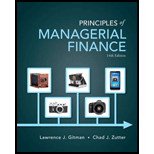
a)
To discuss: The recommendation regarding an investment opportunity.
Introduction:
Every firm requires capital to fund their long-term investments. The typical sources of capital for a firm include equity and debt. Firms raise their capital by selling securities to investors and also by reinvesting profits back to the firm.
b)
To discuss: The recommendation regarding an investment opportunity.
Introduction:
Every firm requires capital to fund their long-term investments. The typical sources of capital for a firm include equity and debt. Firms raise their capital by selling securities to investors and also by reinvesting profits back to the firm.
c)
To discuss: The reasons for the recommendations regarding an investment opportunity.
Introduction:
Every firm requires capital to fund their long-term investments. The typical sources of capital for a firm include equity and debt. Firms raise their capital by selling securities to investors and also by reinvesting profits back to the firm.
d)
To calculate: The weighted average cost of capital (WACC).
Introduction:
The expected average cost from different sources of capital of the company is known as weighted average cost of capital. WACC is calculated as a weighted proportion of the cost of various components in the capital structure.
e)
To discuss: The recommendation regarding investment opportunity based on WACC.
Introduction:
The expected average cost from different sources of capital of the company is known as weighted average cost of capital. WACC is calculated as a weighted proportion of the cost of various components in the capital structure.
f)
To compare: The decisions based on both the methods.
Introduction:
The expected average cost from different sources of capital of the company is known as weighted average cost of capital. WACC is calculated as a weighted proportion of the cost of various components in the capital structure.
Want to see the full answer?
Check out a sample textbook solution
Chapter 9 Solutions
Principles of Managerial Finance (14th Edition) (Pearson Series in Finance)
 Essentials Of InvestmentsFinanceISBN:9781260013924Author:Bodie, Zvi, Kane, Alex, MARCUS, Alan J.Publisher:Mcgraw-hill Education,
Essentials Of InvestmentsFinanceISBN:9781260013924Author:Bodie, Zvi, Kane, Alex, MARCUS, Alan J.Publisher:Mcgraw-hill Education,

 Foundations Of FinanceFinanceISBN:9780134897264Author:KEOWN, Arthur J., Martin, John D., PETTY, J. WilliamPublisher:Pearson,
Foundations Of FinanceFinanceISBN:9780134897264Author:KEOWN, Arthur J., Martin, John D., PETTY, J. WilliamPublisher:Pearson, Fundamentals of Financial Management (MindTap Cou...FinanceISBN:9781337395250Author:Eugene F. Brigham, Joel F. HoustonPublisher:Cengage Learning
Fundamentals of Financial Management (MindTap Cou...FinanceISBN:9781337395250Author:Eugene F. Brigham, Joel F. HoustonPublisher:Cengage Learning Corporate Finance (The Mcgraw-hill/Irwin Series i...FinanceISBN:9780077861759Author:Stephen A. Ross Franco Modigliani Professor of Financial Economics Professor, Randolph W Westerfield Robert R. Dockson Deans Chair in Bus. Admin., Jeffrey Jaffe, Bradford D Jordan ProfessorPublisher:McGraw-Hill Education
Corporate Finance (The Mcgraw-hill/Irwin Series i...FinanceISBN:9780077861759Author:Stephen A. Ross Franco Modigliani Professor of Financial Economics Professor, Randolph W Westerfield Robert R. Dockson Deans Chair in Bus. Admin., Jeffrey Jaffe, Bradford D Jordan ProfessorPublisher:McGraw-Hill Education





